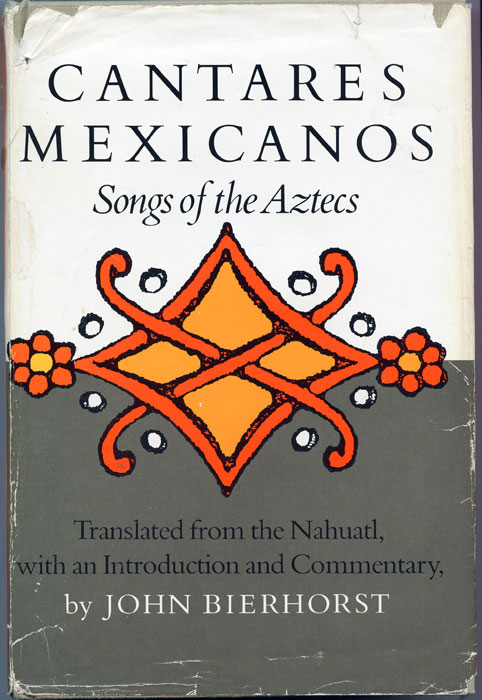Cantares Five Flowers – The Cantares Mexicanos
https://www.wizard101central.com/wiki/NPC:Cantares_Five_Flowers
https://en.wikipedia.org/wiki/Cantares_Mexicanos
https://soprissun.com/flowers-and-songs-aztec-poetry/
A friend of Jade Wind-Sun, Cantares Five Flowers is the seller of Transcendent-Level crafted housing recipes in Azteca. He is also a musician and needs your help retrieving his rattlestick from the Monquistans.
The Cantares Mexicanos is the name given to a manuscript collection of Nahuatl songs or poems recorded in the 16th century. The 91 songs of the Cantares form the largest Nahuatl song collection, containing over half of all known traditional Nahuatl songs. It is currently located in the National Library of Mexico in Mexico City. A description is found in the census of prose manuscripts in the native tradition in the Handbook of Middle American Indians.
The ninety-one songs are made up of short stanzas averaging about thirty words each, presented in the manuscript as hanging paragraphs (of which there are about 1,700). Many of the songs have eight stanzas; most have more, and the longest has 114.
From internal evidence and the contemporary ethnography of Sahagún and other observers, we know that such songs were performed to the accompaniment of the upright skin drum (huehuetl) and the horizontal log drum (teponaztli), each capable of producing two tones spanning an interval such as a fifth or a major third. Gongs, horns, and other instruments could be added; the full program might include costumed dancing, often with mimicry.
A Spanish edition and translation of much of the manuscript was given by the great Mexican scholar, Ángel María Garibay Kintana, in the second and third volumes of his Poesía náhuatl (1965, 1968). It was not until Miguel León-Portilla edited a two-volume Spanish translation of the codex, published by the National Autonomous University of Mexico, that entire Cantares was rendered in Spanish.
A complete paleographic transcription and English translation of the Cantares was published in 1985 by John Bierhorst as Cantares Mexicanos: Songs of the Aztecs, as well as a dictionary and concordance. Although Bierhorst’s transcription was appreciated by scholars for its accuracy and faithfulness to the original manuscript, his translations were criticized as misleading and colored by his view that the Cantares are “ghost songs”, part of a colonial revitalization movement parallel to the ghost dances of the Plains Indians. David Bowles, in his translations of selected poems from the Cantares and other Mesoamerican codices, agrees with León-Portilla and Garibay that the songs are part of a long aesthetic and philosophical tradition predating the Conquest.
The Nahuatl language did not have a specific word for poetry but it did have the concept, a metaphor, “flowers and songs” (“in xochitl in cuicatl”) to indicate poetry. This concept was key in their perception of the world and Aztec mythology. It was the search for truth, for God, for the answers to the compelling and ancestral questions of humankind. It was their philosophy and theology. Poetry came from the god Ometeotl, a dual god: the father and the mother, the convergence of masculine and feminine principles.
Poetry expressed, on one hand, the physical and concrete beauty of nature (the flowers), and on the other, the beauty of human experience (the song), or: the power of communicating, speaking, reasoning about life and its shortness. Life was ephemeral, whereas truth, beauty, and poetry were eternal as Nezahualcóyotl expresses in this poem:
I, Nezahualcóyotl ask about it
Is it true that one lives with roots on earth?
Nothing is forever on earth:
just a little bit here.
Though it be jade, it breaks.
Though it be gold, it wears away.
Though it be quetzal plumage, it is turn asunder.
No forever on earth:
just a little bit here.
But, in this brevity, man searches for God, for truth and beauty, which is what endures:
My flowers will not perish.
My songs will not cease.
I, singer, elevate them
they distribute themselves, they scatter.
Even when the flowers
wither and yellow
they will be taken there:
to the interior of the house
of the golden feathers bird.
And when he finds it, he has found a meaning for life:
Finally, my heart understands it:
I listen to a song,
I contemplate a flower.
Hopefully they won’t wither!
The current list of all the (known) Azteca references are located here.
Although I am well versed in Pop Culture references but I do not claim to have caught them all. Let me know your favorites in the comments and if I’ve missed one you caught, let me know so I can add it to the list.
Text for this article is excerpted from the linked wiki pages.
Cantares Five Flowers image is from Wizard101, and is copyright of KingsIsle Entertainment.
Cantares Mexicanos cover is borrowed from Wikipedia.
Image usage qualifies as fair use under US copyright law.

